Researchers have developed a new method for assessing the impact of ozone-depleting chemicals released into the atmosphere.
The ozone layer sits in the stratosphere - between 15 km and 30 km above the Earth - and provides a shield from some of the sun’s harmful ultraviolet radiation.
Without this ozone protection, higher levels of ultraviolet radiation would reach the Earth’s surface and result in an increased incidence of skin cancer and eye disease as well as adversely effecting plants and crops.
Since the late 1980s, an international agreement called the Montreal Protocol has resulted in the phasing out of ozone-depleting chemicals, particularly chlorofluorocarbons (CFCs) which were used in, for example, refrigeration and air conditioning systems. As a consequence, the hole and thinning that was once seen in the ozone layer has been reducing.
Read more at University of Leeds
Photo Credit: PublicDomainPictures via Pixabay


